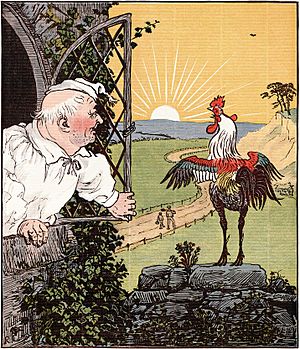This Is the House That Jack Built facts for kids
Quick facts for kids "This Is the House That Jack Built" |
|
|---|---|

Randolph Caldecott illustration from The complete collection of pictures & songs, published 1887 (digitally restored)
|
|
| Nursery rhyme | |
| Published | 1755 |
"This Is the House That Jack Built" is a very old and popular British nursery rhyme. It is a special type of story called a "cumulative tale." This means that each new part of the story builds on what came before it. The rhyme was first published a long time ago, in 1755.
Contents
The Story of Jack's House
This rhyme tells a fun story that grows longer with each line. It starts with a house built by someone named Jack. Then, it adds more and more characters and events. Each new line reminds you of everything that has happened so far.
The Rhyme's Words
Here are the most common words for "This Is the House That Jack Built":
- This is the house that Jack built.
- This is the malt that lay in the house that Jack built.
- This is the rat that ate the malt
- That lay in the house that Jack built.
- This is the cat
- That killed the rat that ate the malt
- That lay in the house that Jack built.
- This is the dog that worried the cat
- That killed the rat that ate the malt
- That lay in the house that Jack built.
- This is the cow with the crumpled horn
- That tossed the dog that worried the cat
- That killed the rat that ate the malt
- That lay in the house that Jack built.
- This is the maiden all forlorn
- That milked the cow with the crumpled horn
- That tossed the dog that worried the cat
- That killed the rat that ate the malt
- That lay in the house that Jack built.
- This is the man all tattered and torn
- That kissed the maiden all forlorn
- That milked the cow with the crumpled horn
- That tossed the dog that worried the cat
- That killed the rat that ate the malt
- That lay in the house that Jack built.
- This is the judge all shaven and shorn
- That married the man all tattered and torn
- That kissed the maiden all forlorn
- That milked the cow with the crumpled horn
- That tossed the dog that worried the cat
- That killed the rat that ate the malt
- That lay in the house that Jack built.
- This is the rooster that crowed in the morn
- That woke the judge all shaven and shorn
- That married the man all tattered and torn
- That kissed the maiden all forlorn
- That milked the cow with the crumpled horn
- That tossed the dog that worried the cat
- That killed the rat that ate the malt
- That lay in the house that Jack built.
- This is the farmer sowing his corn
- That kept the rooster that crowed in the morn
- That woke the judge all shaven and shorn
- That married the man all tattered and torn
- That kissed the maiden all forlorn
- That milked the cow with the crumpled horn
- That tossed the dog that worried the cat
- That killed the rat that ate the malt
- That lay in the house that Jack built.
- This is the horse and the hound and the horn
- That belonged to the farmer sowing his corn
- That kept the rooster that crowed in the morn
- That woke the judge all shaven and shorn
- That married the man all tattered and torn
- That kissed the maiden all forlorn
- That milked the cow with the crumpled horn
- That tossed the dog that worried the cat
- That killed the rat that ate the malt
- That lay in the house that Jack built.
How the Story Builds Up
The rhyme is a great example of a "cumulative story." This means each new line adds a new detail and repeats the previous ones. This makes it easy to remember and fun to say aloud. It helps kids learn about cause and effect, as each event leads to the next.
History and Different Versions
"This Is the House That Jack Built" has been around for a very long time. It was first printed in a book in 1755. Over the years, many people have enjoyed this rhyme.
Changes Over Time
Because the rhyme is so old, its words have changed a little over time. For example, some versions might use "cheese" instead of "malt." You might also hear "priest" instead of "judge," or "cock" instead of "rooster." Sometimes, the words for actions are different, like "shook" instead of "tossed." In some shorter versions, the rhyme might even end with the farmer and not include the horse, hound, and horn.

